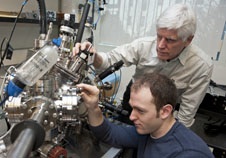Magnetic breakthrough may have significant pull

Northeastern University researchers have designed a super-strong magnetic material that may revolutionize the production of magnets found in computers, mobile phones, electric cars and wind-powered generators.
The research was supported by a three-year, $360,000 grant from the National Science Foundation. The findings — which dovetail with Northeastern’s focus on use-inspired research that solves global challenges in health, security and sustainability — will be published in an upcoming edition of the journal Applied Physics Letters.
“State-of-the-art electric motors and generators contain highly coercive magnets that are based on rare-earth elements, but we have developed a new material with similar properties without those exotic elements,” said coauthor Don Heiman, a physics professor in the College of Science.
Heiman’s work aligns with Northeastern’s existing expertise in this area. The university’s Center for Microwave Magnetic Materials and Integrated Circuits, for example, works to develop next-generation microwave materials and device solutions for radar and wireless communication technologies for U.S. defense and commercial industries.
For this study, the team of researchers, including undergraduates Tom Cardinal and Thomas Nummy and graduate student Steven Bennett, found that the compound manganese gallium can be synthesized on the nanoscale to produce a coercive field that rivals materials containing rare-earth elements, which are considerably more expensive to process and mine.
The need to develop low-cost magnetic materials is at an all-time high. Last year, China, which has cornered the market on the supply of the rare earth elements, purposely reduced production by 40 percent to drive up prices throughout the rest of the world.
As Heiman put it, “The government would be in a bind if it had to rely on China to produce hybrid cars and wind generators.”
He presented the team’s research in November in Scottsdale, Ariz., at the 56th Annual Conference on Magnetism and Magnetic Materials. Representatives of Toyota, LG Electronics and hard-drive manufacturers Seagate and Hitachi Global were particularly interested in the findings.
“It garnered a lot of interest,” Heiman said.
He praised the contribution of the trio of student-researchers, whose lab work taught them how to approach scientific problems in new ways. “The goal is to get students in the lab as soon as possible,” Heiman explained. “In class, students work on problems with specific answers, but when you enter the real world, it’s not like that.”
View selected publications of Don Heiman in IRis, Northeastern’s digital archive.





